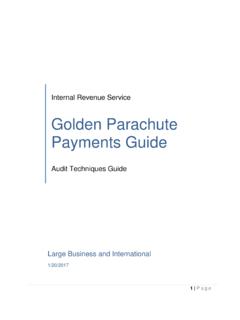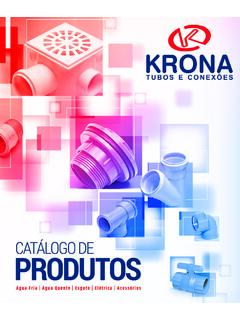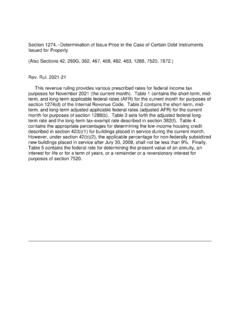Transcription of Section 280G: The Law and Lore of the Golden Parachute ...
1 Section 280g : The Law and Lore of the Golden Parachute Excise Tax, Part I: The Structure and Operation of Section 280g . Matthew M. Friestedt and J. Michael Snypes, Jr.*. INTRODUCTION ing or eliminating Golden para- business practices. Despite chute tax consequences. multiple Internal Revenue Ser- The Golden Parachute tax vice ( IRS ) notices, dozens of under Internal Revenue Code The Golden Parachute tax private letter rulings and a Sections 280g and 4999 can rules are complicated and con- handful of published tax court have a signi cant, adverse fusing, and often result in unin- cases addressing Section impact on change in control tuitive outcomes. Enacted in 280g , many questions about payments, penalizing both the 1984, Section 280g was in- its application remain.
2 As a employer and the executive. tended to combat perceived result, disparate practices have Section 280g denies a corpo- abuses in management com- developed and sometimes rate tax deduction for, and pensation practices at large competing interpretations have publicly-traded corporations Section 4999 imposes a non- evolved. We focus on those that were viewed as either hin- deductible 20% excise tax on aspects of the Section 280g . dering M&A activity or depriv- the recipients of, payments rules that lack clarity and dis- ing shareholders of transaction exceeding a statutory thresh- cuss their application in prac- gains. Two sets of proposed old that are made to senior Treasury Regulations followed tice, addressing common, as executives in connection with in 1989 and 2002, culminating well as less frequently occur- a change in control.
3 As the in nal regulations (the Final ring issues. Section 280g gross-up has Regulations ) in 2003. This article is the rst install- become less common in recent Many Section 280g rules do ment of a two-part series, and years, due to, among other not have clear guidance. Both focuses on the operation Sec- things, pressure from share- the statutory and regulatory tion 280g , discussing circum- holder advisory rms, corpora- language is broad, in some stances under which Section tions and their executives have cases ambiguous, and in many 280g may be triggered, the a common interest in minimiz- cases at odds with common individuals impacted and the *MATT FRIESTEDT is a partner at Sullivan & Cromwell LLP and leads the Firm's executive compensation M&A.
4 Practice. He is experienced in handling all matters involving the compensation of senior executives, including employment, change in control, equity compensation and severance arrangements. He has worked on M&A transactions worth over $450. billion in 2015 and 2016 (including over 30 deals worth more than $1 billion) and has worked on approximately $1 trillion of M&A transactions during the last 11 years. He also regularly advises on governance issues. MIKE SNYPES was Special Counsel at Sullivan & Cromwell LLP at the time this article was written, and has recently joined Debevoise & Plimpton LLP as Counsel. He has over 10 years' experience handling a broad range of issues related to executive compensation, including in connection with M&A transactions.
5 Journal of Compensation and Bene ts E July/August 2017. 2017 Thomson Reuters 25. Journal of Compensation and Bene ts composition and valuation of of $400 and be subject to an iii. Change in effective Parachute payments. The sec- Excise Tax of $80. control. If a transaction does ond installment of the article not constitute a change in own- Section I: addresses special issues aris- ership or a change in owner- TRANSACTIONS TRIG- ing in connection with two sig- GERING Parachute ship of a substantial portion of ni cant avenues to mitigate PAYMENTS a corporation's assets, there is Section 280g , the exclusion a rebuttable presumption that for reasonable compensation A.
6 Change in Control a change in the effective con- for services performed and the trol occurs on the date that, In order to have Parachute shareholder approval excep- within a 12-month period, ei- payments under Section 280g , tion available for certain private ther (i) any one person, or there must rst be a Section companies. persons acting as a group, 280g Change in Control . ( CIC ). CIC transactions may acquires ownership of 20% or Generally, a Section 280g . occur in one of three forms: more of the total voting power Parachute payment is a pay- of the corporation's stock or (ii). ment in the nature of compen- i. Change in ownership: a majority of the board of direc- sation that is contingent on a Any one person, or more than tors is replaced by directors change in control , that, when one person acting as a group, whose appointment or election aggregated with all other para- acquires stock resulting in is not endorsed by a majority chute payments received by a ownership of more than 50% of the corporation's board of disquali ed individual (or DI ).
7 Of the total fair market value directors before the appoint- equals or exceeds three times ( FMV ) or total voting power ment or election date. Absent the DI's average annual com- of a corporation's these events, there is a rebut- pensation for the ve years preceding the change in con- ii. Change in ownership of table presumption that a trol (the Base Amount ), un- a substantial portion of a cor- change in effective control did less an exception is otherwise poration's assets: Any one per- not occur. Where a share- available. If the DI receives son, or persons acting as a holder holds more than 20% of Parachute payments, then pay- group, acquires, within a 12- a corporation's voting power, ments in excess of one times month period, assets from the the acquisition of additional a DI's Base Amount (the ex- corporation with a total gross voting power does not trigger cess Parachute payment )
8 Will FMV equal to or more than a subsequent change in own- generally become non- one-third of the total gross ership or change in effective deductible to the paying corpo- FMV of all of the corporation's ration and subject to a 20% assets (measured without re- excise tax levied on the DI (the gard to liabilities) immediately 1. Under What Circum- stances Can a Merger Be Excise Tax ). For example, as- before the acquisition or acqui- Treated As A CIC? sume a base amount of $100, sitions (the Asset Test ). An a resulting three times limit of asset transfer is not treated as A merger will typically trigger $300 and aggregate Parachute a CIC if before the transfer the a change in ownership of one payments of $500; assuming corporation's shareholders of the two merging companies.
9 No exceptions were otherwise own more than 50% of the In determining whether per- available, the DI would have FMV or voting power of the sons are acting as a group , an excess Parachute payment Code Section 318 constructive Journal of Compensation and Bene ts E July/August 2017. 2017 Thomson Reuters 26. Section 280g . ownership rules Where ration's value or voting power, ceeds one-third of the value of a shareholder owns stock in including through accretion all of the corporation's assets). both corporations that are party resulting from anti-dilution pro- In that case, there would be a to the merger ( Corporation A visions or the retirement or CIC of both the selling parent and Corporation B ), the redemption of stock.
10 In addi- and the subsidiary. overlapping shareholder is tion, if any single person (or ii. Subsidiary is Not an Af- deemed to be acting with a persons acting in concert) pur- liated Group Member. A sub- group only with other Corpora- chased 20% or more of the sidiary may not be a member tion A shareholders for its Cor- corporation's total voting of a parent's Af liated Group, poration A shares, and only power, then a CIC would be for a number of technical rea- with other Corporation B share- presumed (but could be rebut- sons in the way that Af liated holders for its Corporation B ted if other control rights were Group is de ned for purposes shares. Thus, in a merger of not present).













